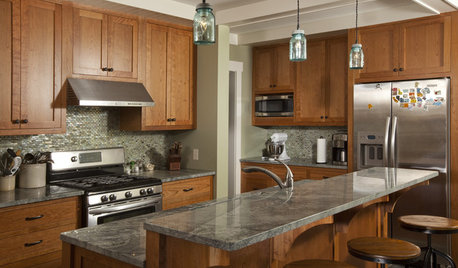Help choosing Heat Pump in Florida – Load Calc from Online Source
User
8 years ago
Featured Answer
Sort by:Oldest
Comments (10)
Related Discussions
Geothermal heat pump vs air source heat pump vs gas
Comments (27)Air source heat pumps don't make sense in areas where winter temps frequently fall below 32 degrees. Once you get below freezing, you will be running the auxillary heat a lot. If you decide to go the air source route, you will want a second stage gas fired auxillary heat. I live in the mid-atlantic region in the mountains and selected GT. That choice was coupled with a blown cellulose insulation package. My other choice was a propane heat/electric AC with a foam insulation package. Both options were roughly the same install cost. Both would have provided similar energy efficiency. At the time we selected, propane was 3.75 a gallon and rising (with no end in sight) so we went with GT. The delta cost for the GT system (above the cost for a HE propane heat and electric AC system) was $15,000 for the heat pumps and loop plumbing (including pumps) plus $17,000 for digging the pit. The pit excavation should not have cost as much as it did but it is a 12 ton system and the hole was gigantic (120' x 48' x 6'). We live on a mountain and hit a bunch of boulders that required special equipment to get out. Rocky soil also required a 1' base of stone dust to cover the loop piping. The total cost for the GT HVAC system including all ducting was $50,000 plus the pit excavation cost of 17K. It is a large investment and I would only recommend it if you plan to live in the house a very long time. My heating bills are great - maybe 300 dollars maximum a month during peak winter for an 8500 square foot home (5900 living and the rest a condiitoned but unfinished basement). Make sure that whatever equipment you choose can be maintained by more than 1 very qualified HVAC company who has many years of GT experience. In my area there is only 1 GT company who has over 20 years of experience but I am stuck with them for maintenance. There have been times when I wanted to fire them but cannot. Local competition is a good thing. Also - if you build a tight home make sure that you consider ventilation and dehumidification in the HVAC design. I wound up adding both a whole house dehumidifier and energy recovery vent after we moved in becuase we had basement moisture issues as well as stale air in the winter. Tight homes are great for energy efficiency but can create health issues too. It is easy to deal with as long as you plan for it. Good luck with the build....See MoreNeed help choosing new heat pump system
Comments (12)Thanks again for your input. I think we've decided on a Trane. The Carrier our friend quoted was the base model 25HBC536A with FX4DNF037T and even at $3368 it'd be a few hundred more for permit and hurricane pad, which would make it close to the cost of the company who quoted 25HCC536 and 25HBC536 models. Also with our friend, we'd need to pay it all by check. we have the funds, but Carrier is offering zero percent for a year or so - minus well use thier money for a year! Both the Carrier Comfort and Trane XR15 seem comprable in function and effeciency, so then I had to decide which one looked better to me. That's a woman for ya! :) I'm going to try to get the company who quoted the 2 Carriers and the TRANE TWR536 with TEH3F4ZB $4150 to come down a few hundred and see if he'll include the $125 for the MERV 11 1 year filter. Is it common to ask for lower price on this type of service? The only company that even asked about our windows was the One Hour AC franchise that did the only load calculation. He factored our house needs 2.5 ton unit. We had the windows in a few months before the ac broke and there was not really a significant change in our electric bill. We did go from aluminum single pane 30 year old windows to impact laminated insulated glass vinyl windows. You could feel the heat coming in on the old - the new you can barely hear any outside noise and it's got a coating that helps block the solar gains. neohioheatpump - it's always hot here in Daytona! ;) I think we're only expected to not hit 90 today because it's raining....See MoreIs my new Trane system oversized?
Comments (16)Mike, Dunes and 77. The correct air handler was installed. I contacted some of the other people who did the Manual J calculations, they all used the outside measurements of the house (1250) sq feet and came up with 2.3 tons. One person measured the rooms with vents (eliminated closest and hallways) and came up with 875 feet. He said 2 ton. Big difference. We used to have a 2 ton unit, but we lost a large shade tree, it is getting much hotter in the summers and the old unit wouldn't maintain 77 degrees during the day. I still don't know how to size the tonnage correctly. On to the noise, The installer sent over a Tech and he use an instrument called an Alnor Balometer, thing with a big hood, to measure the airflow out of the vents. The tech said with the blower set on low and 0.1 static pressure the blower would output 979 CMF Here are the measurements he got in CFM: Room 1: 185 Room 2 Vent 1: 145 Room 2 Vent 2: 200 Room 3: 195 Room 4: 250 Room 5: 195 Room 6: 390 He left scratching his head. I had the ductwork re-done two years ago and it seems they might not have done a very good job, but access is very difficult. I'm at a complete loss....See MoreHVAC Load Calcs - novice homeowner
Comments (43)Happy to see this subject brought up although I'm sure most building new, didn't make it this far. I think the OP got "shorted" but no worse than most building new in this current building climate. With such a hot market one has to be careful they don't spook the best or only opportunities. I think it's important to get a 2 stage system as a minimum. Getting a properly sized system is much like getting a building envelope to perform at current levels of international energy code. For most people, the best chance is to hire a design and building team who already understand the details from past projects. At this stage of the game it's often too late. Ductwork in a vented attic or low levels of roof deck insulation can effect cooling loads as much as western windows depending on the details. Martin Holladay has the best articles on this topic. Calculating cooling loads and When do I need to perform a load calculation? are free while Who can perform my load calculation? is behind the paywall but relevant here. When builders get experienced with a particular plan, the need for load calcs diminish. For custom designs costing hundreds of thousands, using a third party to help with design, sizing and commissioning can be a wise investment. Some architects and builders include this with their services. Energy Star is the most common way to achieve a better level of verified performance. This goes beyond energy use to include comfort, indoor air quality and durability. The program ensures bath vent fans, outdoor air ventilation systems and kitchen vent hoods are installed properly. With a reported energy savings of $300 a year, simple paybacks are reasonable. Not all HERS raters do load calcs but most can point you in the right direction. If you only care about HVAC system design, hiring the right 3rd party can help. If building in the south, try Allison Bailes with Energy Vangaurd. He has influenced the need for better rules of thumb, like 1 ton per 1000 sqft for homes that meet international levels of energy code. This can be useful when comparing results to what the HVAC contractor wants which is typically closer to 1 ton per 500 sqft. I find HVAC contractors more willing to install smaller systems when they have stamped letters from a mechanical engineer, which in our case is the HERS rater....See MoreUser
8 years agoUser
8 years agoUser
8 years agomike_home
8 years agoUser
8 years agomike_home
8 years ago
Related Stories

DECLUTTERINGDownsizing Help: Choosing What Furniture to Leave Behind
What to take, what to buy, how to make your favorite furniture fit ... get some answers from a homeowner who scaled way down
Full Story
BEDROOMSHow to Choose the Perfect Bedsheets
Don't lose any shut-eye over scratchy or ill-fitting sheets; our mini guide to materials, thread count and fit will help you sleep tight
Full Story
HEALTHY HOMEHow to Choose a Home Water Filtering System
Learn which water purification method is best for your house, from pitchers to whole-house setups
Full Story
KITCHEN CABINETSCabinets 101: How to Choose Construction, Materials and Style
Do you want custom, semicustom or stock cabinets? Frameless or framed construction? We review the options
Full Story
BATHROOM DESIGNHow to Choose the Best Drain for Your Shower
Don't settle for a cheap fix when you can pick a shower drain that suits your style preferences and renovation codes alike
Full Story
FLOORSWhat to Ask When Considering Heated Floors
These questions can help you decide if radiant floor heating is right for you — and what your options are
Full Story
MOST POPULAR9 Real Ways You Can Help After a House Fire
Suggestions from someone who lost her home to fire — and experienced the staggering generosity of community
Full Story
PETS6 Ways to Help Your Dog and Landscape Play Nicely Together
Keep your prized plantings intact and your dog happy too, with this wisdom from an expert gardener and dog guardian
Full Story
BATHROOM DESIGNHow to Choose Tile for a Steam Shower
In steamy quarters, tile needs to stand up to all that water and vapor in style. Here's how to get it right the first time
Full Story
GREAT HOME PROJECTSHow to Add a Radiant Heat System
Enjoy comfy, consistent temperatures and maybe even energy savings with hydronic heating and cooling
Full Story


tigerdunes